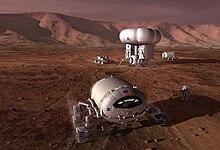
Crewed Mars rovers (also called manned Mars rovers[2]) are Mars rovers for transporting people on the planet Mars, and have been conceptualized as part of human missions to that planet.[3][4]
Two types of crewed Mars rovers are unpressurized for a crew in Mars space suits, and pressurized for the crew to work without a space suit. Pressurized rovers have been envisioned for short trips from a Mars base, or may be equipped as a mobile base or laboratory.[4]
Crewed Mars rovers are a component of many designs for a human mission to the planet Mars. For example, the Austere Human Missions to Mars proposal included two rovers on its uncrewed power and logistics cargo lander. Each rover could hold a crew of two in a pressurized environment, with power coming from a Stirling radioisotope generator.[3]



In the 1960s, the post-Mariner 4 design for a Mars Excursion Module, by Marshall Space Flight Center, including a cargo version carrying a pressurized Mobile Laboratory for Mars, called MOLAB.[5] One of the ideas for Molab was for it to touch down on its wheels, what was called a "rover first" concept.[4] MOLAB had a pressurized cylinder for crews to operate in a shirt-sleeve environment even on an extraterrestrial surface.[4]
Mars One, a Mars colonization plan intended to be funded by a TV show, planned an unpressurized crewed rover capable of traveling 80 km (50 miles).[6] Astrobotic Technology was announced as a possible supplier.
The Manned Mars Exploration Rover (MMER) won a design award in 2010. Some features included live-aboard capability, a winch, airlock, and six foam core wheels. It featured modular construction so it could be assembled from smaller parts, and the suggested power source was radioisotope batteries.[7] An example of RTG use is the Cassini-Huygens spacecraft, with a radioisotope power system that produced several hundred watts of electrical power. It produces this amount of power continuously with a slow decline over decades, with some of the heat given off by radioactive decay going to the production of electricity and a larger amount radiated as waste.[8]
In 2017, the Park Brother's Concepts debuted their Mars Rover design, which featured a six-wheel design, enclosed cab, and a mobile laboratory concept.[9] The rover concept is a Non-NASA design, but did debut at the Kennedy Space Center's Summer of Mars and is back dropped by agencies goal of getting humans to Mars by the early 2030s.[9] Car and Driver magazine reported on this event, dubbing the rover a 'Mars Car' and noting the designers and various specifications of the vehicle, such as its size.[2]
An example of an in-house NASA design for rover is the wheeled version of the Space Exploration Vehicle, which has a version for outer space.[9][10] An early version of the SEV rover was tested in 2008 by NASA in the desert.[10] The SEV for space or roving missions was designed to support two humans for 14-days, and would include a toilet, sleeping logistics, and one version has suitports to support EVAs.[10][11] Another concept is a windows that allow looking at objects very close to the front of the rover but on surface (down and to the front).[10]

An example of criteria for a crewed Mars surface rover was expressed by NASA in the surface variant of the aforementioned SEV, in development during the 2010s.[15] The 1980s era "Case for Mars" design suggest a medium-range rover with two compartments, one which could be depressurized and opened up to the Mars atmosphere, and a driving compartments which could remain pressurized during this time.[16] The same study also suggested a bigger, long-duration rover with tracks and robotic arms, in addition to other types in that crewed Mars mission concept.[17] Airlock design, especially for EVA, is an area of study for pressurized rovers.[15]
Design ideas for crewed and/or pressurized rovers:[15]
Additional possible technologies:
A 2004 analysis of a crewed Mars surface mission suggested the following types of rovers:[18]
In crewed Mars missions, rovers are sometimes grouped under the term "Mars surface elements".[18]

Unpressurized Mars rovers would lack a pressurized environment for the crew, being functionally similar to the Lunar Roving Vehicle. There are several advantages to having an unpressurized rover as opposed to a pressurized variant, such as a reduced weight. Since range of a potential rover that carries crew from base is important, a light weight is an advantage and therefore is a good choice for long range missions. An unpressurized rovers can also be used to move heavy load, travel short distance from base to the location of a bigger pressurized rover.[19]